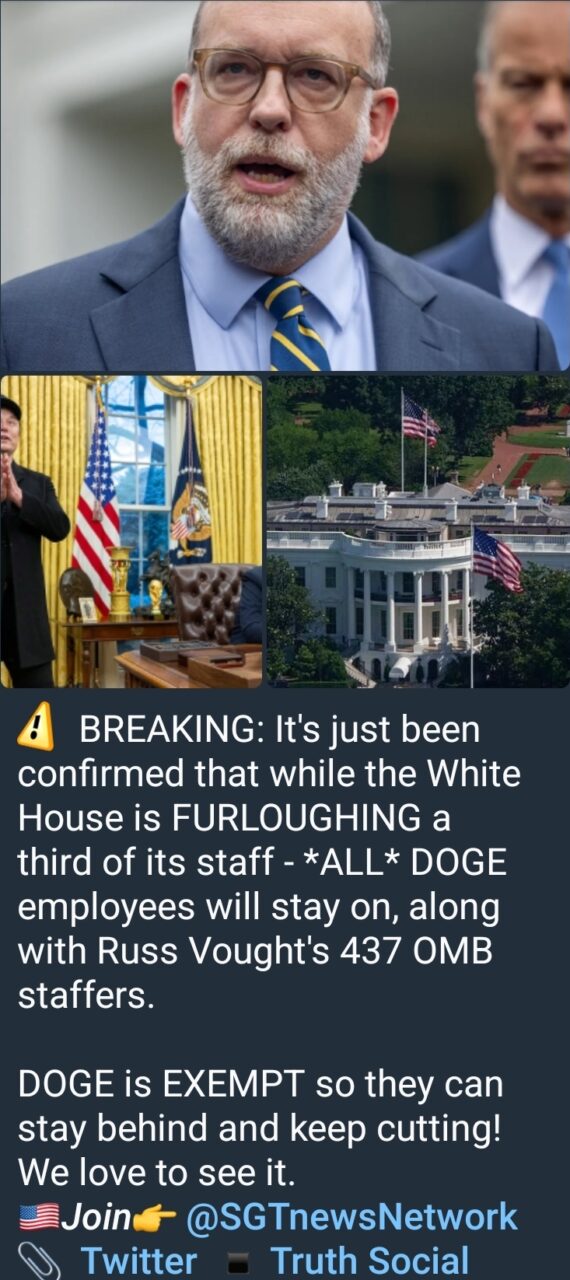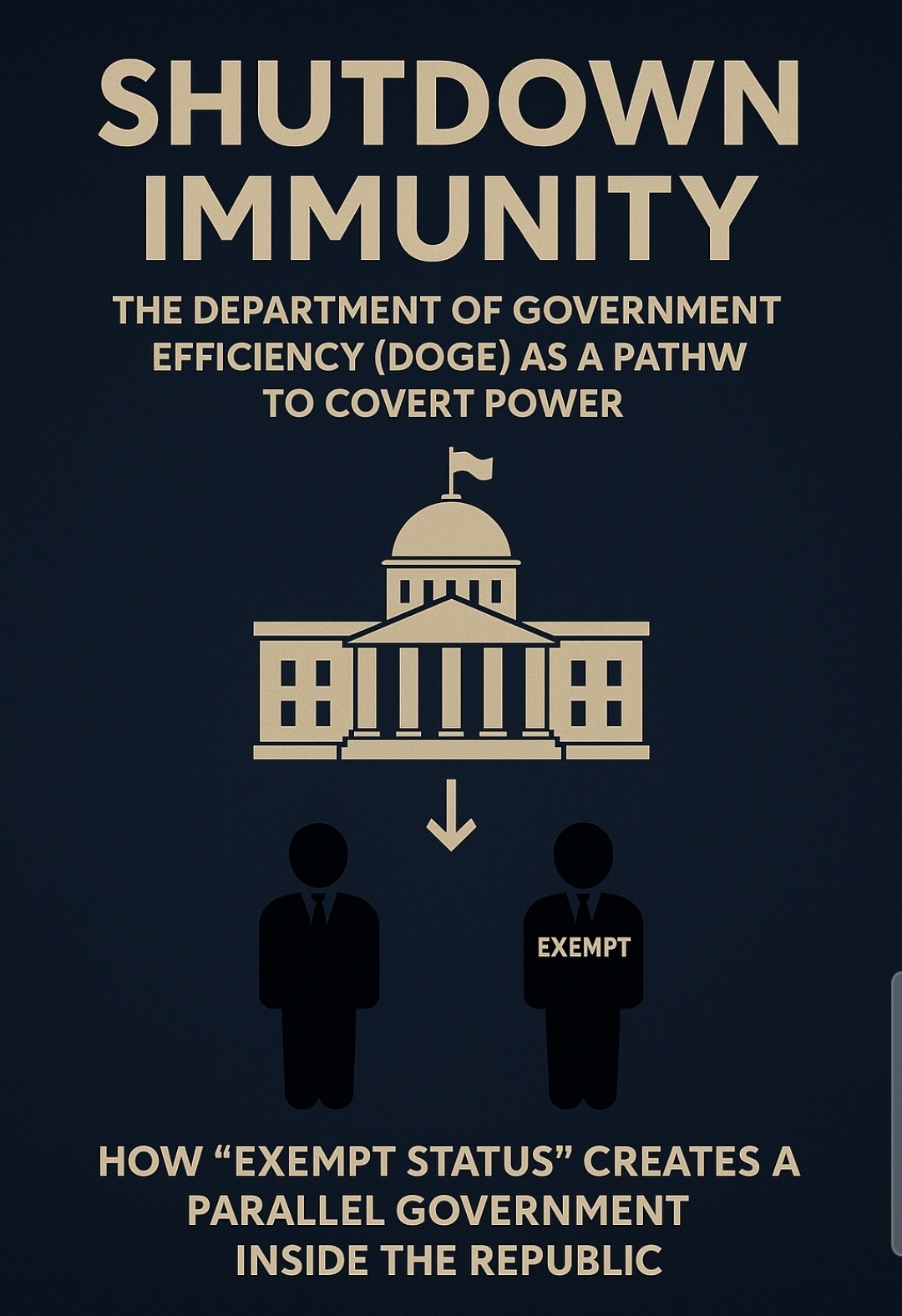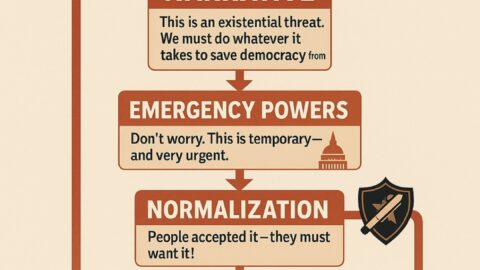How “Exempt Status” Creates a Parallel Government Inside the Republic and can centralize control while the rest of the government sleeps

Every political era reveals its true priorities during a crisis — and nothing exposes them like a government shutdown. When essential services halt, when workers are furloughed, and when the nation is told to “tighten its belt,” the agencies that remain operational tell you who really governs.
Now, amid mass furloughs, the Department of Government Efficiency (DOGE) — a technocratic creation marketed as an “AI-driven cost cutter” — remains fully exempt. While a third of the White House staff sits idle, DOGE and its allied bureaucratic networks continue operating in the shadows, untouched, unaccountable, and increasingly powerful.
At first glance, DOGE looks like reform — a modern efficiency agency designed to streamline bloated systems. But beneath its polished rhetoric lies something far more transformative: a parallel government architecture, built to survive political transitions, bypass constitutional limits, and gradually centralize power under algorithmic management.
This is not efficiency — it’s evolution through consolidation.
It’s “Business as Usual” 2.0 — the same quiet merger between state and corporate power that defined every stage of the modern administrative empire, now upgraded with artificial intelligence.
Understanding DOGE’s “shutdown immunity” isn’t a bureaucratic curiosity; it’s a glimpse into how governance itself is being rewritten. Each exemption, each algorithmic decision, each hidden AI audit represents a transfer of sovereignty — from elected accountability to machine logic, from the republic to the technocracy.
The public narrative frames it as harmless modernization. But in truth, it’s a hostile takeover masquerading as reform — one that converts democratic governance into a corporate acquisition, with citizens as unpaid data assets and efficiency as the new god of control.
If an office can keep operating during a shutdown while others are benched, that office quietly becomes the center of gravity. “Exempt” status during lapses in funding isn’t just a payroll quirk—it’s a power advantage. Our concern in Is the Department of Government Efficiency (DOGE) Working Like an Acquisition, Merger & Hostile Takeover Plan…? was simple: a unit that stays on when others go dark can reshape, consolidate, and set defaults that stick long after the crisis ends.
What “Exempt” Really Buys — In Everyday Terms
When a government office like DOGE is labeled “exempt,” it means it keeps working even when everyone else is told to stay home during a shutdown. That might sound harmless, but it quietly shifts real power. Here’s how:
1. Continuity of Action
When other desks are empty, the people still working make all the urgent calls. They decide what gets delayed, what gets canceled, and what moves forward. Because no one else is there to review or object, they can push through decisions that would normally take months of oversight. In a sense, they get to drive the car while everyone else is asleep in the back seat.
2. Agenda-Setting
In government, the person who writes the first draft usually wins. When offices reopen, no one wants to start from scratch—they just build on whatever’s already written. So if DOGE drafts new “efficiency” policies during a shutdown, those ideas become the new baseline before anyone else even gets back to work. What starts as “temporary” often becomes permanent simply because it’s already in motion.
3. Information Advantage
During a shutdown, most information stops flowing—but not for those who stay behind. The team that still receives daily reports, emails, and vendor updates ends up knowing more than anyone else. When operations resume, they control what information gets shared, what gets buried, and what gets spun. That’s how narratives—and policies—get shaped without debate.
4. Path Dependency
Once a new rule, system, or budget cut is put in place, reversing it is incredibly hard. It’s like pouring concrete—once it sets, you need a jackhammer to undo it. Even if other agencies disagree later, they’ll usually adapt rather than fight to reverse it, because the cost and effort to go back are too high. That’s how “temporary” shutdown decisions become permanent structures of power.
In short: “Exempt” doesn’t just mean “still working”—it means “working without competition, without oversight, and with a massive head start.”
During every shutdown, the exempt teams quietly redraw the map—and when everyone else returns, the borders have already moved.
The consolidation pattern (why this echoes a takeover play)
This is the quiet strategy that turns a temporary project into a permanent power center. It’s not a conspiracy theory; it’s just how systems consolidate when no one is watching. Here’s how it happens:
1. Special Funding Stream
When most government offices depend on annual budgets approved by Congress, “special” funding streams — like those used by DOGE — act as a secret lifeline. They can keep operating even when the rest of the system shuts down. While everyone else is furloughed, they’re still writing rules, building software, and pushing changes that no one can challenge in real time.
2. Crisis Window
Crises create speed and chaos — and that’s when oversight disappears. In a shutdown, pandemic, or emergency, “efficiency teams” are told to move fast. They make big structural decisions (cutting departments, merging programs, adopting new technologies) without the normal checks and balances. Later, everyone assumes those changes were necessary because “it was a crisis.”
3. Embed & Standardize
Next, they quietly plant their people, systems, and software into other agencies — sometimes called “cross-agency teams.” They roll out dashboards, templates, and digital tools that become essential to daily operations. Once those systems are in place, everyone else must adapt to them — meaning DOGE’s framework becomes the new normal.
4. Mandate by Momentum
Once a new policy, pilot program, or digital system is halfway done, leaders justify continuing it by saying, “We can’t stop mid-stream.” No one wants to lose progress, so even temporary or experimental programs become permanent by default. That’s how pilots quietly turn into policies without a single new law being passed.
5. Harden the Perimeter
Finally, when people start asking questions, the justification shifts to “security” or “efficiency.” Oversight requests are denied for fear of “slowing progress” or “risking national security.” The system walls itself off, claiming it’s too critical or too technical to question — and just like that, control is centralized and self-protecting.
In short:
This is the same playbook corporations use in hostile takeovers — keep your team working when others can’t, control the tools and standards everyone depends on, and by the time the dust settles, you’ve become indispensable. The government calls it “efficiency.” In business, it’s called acquisition. In reality, it’s control through permanence — a quiet shift from democracy to dependency.
Indicators to watch (audit-ready)
- Funding architecture: Is the office paid via transfers, fee accounts, or other non-appropriated streams that sidestep Congress?
- Scope creep during shutdowns: New “temporary” standards, vendor shifts, or staffing realignments made while others are furloughed.
- Cross-agency embeds: “Tiger teams” placed inside independent agencies to control data, dashboards, or hiring.
- Irreversible defaults: Decommissioned tools, retired contracts, or sunset clauses that quietly expire while normal oversight is offline.
- Opaque exemptions: Who designates “exempt,” by what criteria, and with what public record?
Playbook: how shutdown immunity centralizes power
- Own the rails: Control the metrics, dashboards, and ticketing queues other offices must use when they return.
- Rewrite the calendar: Announce aggressive post-shutdown timelines only you can meet; everyone else is forced to align.
- Vendor lock-ins: Move “critical” services to platforms under your supervision; claim migration back would be risky.
- Policy by pilot: Launch “efficiency pilots” that reassign authorities; declare success based on your own KPIs.
Constitutional and civic risks
- Separation of powers erosion: Executive units with crisis continuity can effectively legislate by procedure.
- Democratic lag: Public comment, IG review, and committee oversight arrive after the cement cures.
- Parallel governance: A small node functions as a permanent operations government, while the visible government opens and closes like a storefront.
Guardrails & fixes (what to demand now)
- Sunlight: Publish exemption criteria, staff counts working during lapses, and all actions taken while others are furloughed.
- Shutdown journals: Daily public logs of decisions, contracts, data migrations, and terminations executed during lapses.
- Reverse-on-resume rule: Any structural change made during a lapse auto-reverts unless explicitly re-approved within 30 days of reopening.
- Funding discipline: Prohibit critical governance functions from using non-appropriated workarounds without statutory authorization and hard sunset dates.
- Independent audit triggers: GAO/IG automatic reviews of any office that remains fully active during a lapse.
- No stealth embeds: Temporary embeds expire at reopening unless re-authorized in public.
- Data sovereignty: Core government data and identity rails must remain under statutory control—not executive carve-outs or vendor EULAs.
What to ask your representatives
- Which units stayed “exempt,” why, and under what legal authority?
- What decisions, migrations, or contracts did they execute during the lapse?
- What will be undone unless publicly re-approved?
- How will Congress prevent policy-by-shutdown next time?
Bottom line
Shutdown immunity is power. If an office uses that immunity to change structures, reassign authorities, or lock in platforms, you’re not watching “efficiency”—you’re watching consolidation. The fix isn’t to kill modernization; it’s to bind it to lawful process, sunlight, and reversibility.
The Architecture of Parallel Governance
DOGE looks like a reform office. Functionally, it behaves like a systems integrator for a new regime: policy made by pipelines, not by votes. Here’s the blueprint to watch.
1) Control the Rails, Not the Trains
- Data rails: Centralize identity (who you are), telemetry (what you do), and payments (how you transact).
- Policy-by-metrics: “Efficiency dashboards” become the real legislature—what gets measured gets mandated.
- API federalism: Agencies don’t get orders; they get interfaces. If your system can’t talk to the DOGE stack, your program withers.
Why it matters: Whoever owns the rails can silently change outcomes without new laws—just new defaults.
2) Funding Outside the Republic
- Exempt streams: Non-appropriated accounts, fee-for-service, foundations, or “shared services” let DOGE operate when others are furloughed.
- Evergreen contracts: Multi-year vehicles with vague scopes enable mission creep during “continuity” periods.
Why it matters: Power that doesn’t pause for Congress doesn’t answer to Congress.
3) AI as an Authority Multiplier
- Triage engines: Models that “prioritize” audits, benefits, or investigations quietly redraw who gets help—or scrutiny.
- Risk scores as law: When an AI score gates permits, loans, or speech amplification, code becomes coercion.
- Human-in-the-loop theater: Reviewers rubber-stamp model outputs, preserving the appearance of oversight.
Why it matters: AI converts policy preference into automated hierarchy—fast, scalable, and hard to contest.
4) Vendor-State Fusion
- Managed clouds: Core government data lives under private ToS. “Security” arguments cement monopolies.
- Platform lock-ins: Identity, content moderation, and payment rails are “outsourced,” yet enforced as if they were law.
- Rotating cadres: The same architects cycle between contractor, foundation, and “temporary” government posts.
Why it matters: Private policies become public punishments—without constitutional constraints.
5) Crisis Windows = Power Windows
- Shutdown immunity: When others go dark, DOGE rewrites calendars, standards, and procurement baselines.
- Pilot-to-policy: “Temporary efficiencies” harden into permanent requirements once everyone has retooled to comply.
- Path dependence: Reversing a default later requires 10× the cost—so it never happens.
Why it matters: Crises are the on-ramps for structural change.
6) Narrative Shielding
- Language laundering: “Efficiency,” “best practices,” “safety,” “mis/disinfo,” and “AI risk” justify centralization.
- Moral outsourcing: Objections are framed as anti-innovation or anti-safety; critics become “obstacles.”
Why it matters: If the framing wins, the debate never starts.
How to Spot DOGE’s Footprint (Field Guide)
- New mandatory dashboards with no statute behind them.
- Exempt staffing memos during lapses or emergencies.
- Cross-agency “tiger teams” embedded without formal charters.
- Procurement pivots that concentrate services to one cloud or identity provider.
- Model-gated services (benefits, audits, permits) with opaque scoring.
- “Temporary” standards that persist after the crisis.
- Public-private MoUs that bind agencies to private moderation or risk policies.
What Breaks the Parallel State
- Law > Interface: Require statutory authority for any new mandatory data feed, dashboard, or score.
- Sunlight by Design: Publish model cards, training data sources, exemption lists, and shutdown journals daily.
- Reverse-on-Resume Rule: Any structural change made during a lapse auto-reverts unless re-approved in 30 days.
- Data Sovereignty: Core identity/content/payment rails must be under public law, not vendor ToS; portability by default.
- Common Carrier Duties for Dominant Platforms: Neutral, auditable, with due process for users and agencies alike.
- Funding Discipline: No critical governance via non-appropriated workarounds without explicit statute and sunset.
- Independent Audits: GAO/IG triggers for any “exempt” unit; publish findings and corrective actions.







